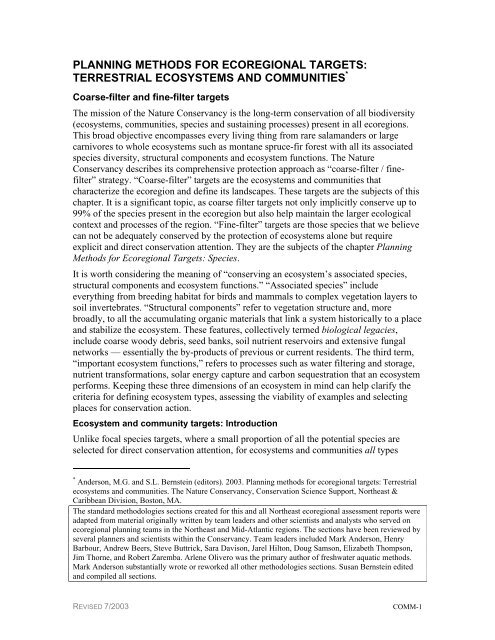Full ecoregional plan - Conservation Gateway
Full ecoregional plan - Conservation Gateway
Full ecoregional plan - Conservation Gateway
- No tags were found...
You also want an ePaper? Increase the reach of your titles
YUMPU automatically turns print PDFs into web optimized ePapers that Google loves.
PLANNING METHODS FOR ECOREGIONAL TARGETS:TERRESTRIAL ECOSYSTEMS AND COMMUNITIES *Coarse-filter and fine-filter targetsThe mission of the Nature Conservancy is the long-term conservation of all biodiversity(ecosystems, communities, species and sustaining processes) present in all ecoregions.This broad objective encompasses every living thing from rare salamanders or largecarnivores to whole ecosystems such as montane spruce-fir forest with all its associatedspecies diversity, structural components and ecosystem functions. The NatureConservancy describes its comprehensive protection approach as “coarse-filter / finefilter”strategy. “Coarse-filter” targets are the ecosystems and communities thatcharacterize the ecoregion and define its landscapes. These targets are the subjects of thischapter. It is a significant topic, as coarse filter targets not only implicitly conserve up to99% of the species present in the ecoregion but also help maintain the larger ecologicalcontext and processes of the region. “Fine-filter” targets are those species that we believecan not be adequately conserved by the protection of ecosystems alone but requireexplicit and direct conservation attention. They are the subjects of the chapter PlanningMethods for Ecoregional Targets: Species.It is worth considering the meaning of “conserving an ecosystem’s associated species,structural components and ecosystem functions.” “Associated species” includeeverything from breeding habitat for birds and mammals to complex vegetation layers tosoil invertebrates. “Structural components” refer to vegetation structure and, morebroadly, to all the accumulating organic materials that link a system historically to a placeand stabilize the ecosystem. These features, collectively termed biological legacies,include coarse woody debris, seed banks, soil nutrient reservoirs and extensive fungalnetworks — essentially the by-products of previous or current residents. The third term,“important ecosystem functions,” refers to processes such as water filtering and storage,nutrient transformations, solar energy capture and carbon sequestration that an ecosystemperforms. Keeping these three dimensions of an ecosystem in mind can help clarify thecriteria for defining ecosystem types, assessing the viability of examples and selectingplaces for conservation action.Ecosystem and community targets: IntroductionUnlike focal species targets, where a small proportion of all the potential species areselected for direct conservation attention, for ecosystems and communities all types* Anderson, M.G. and S.L. Bernstein (editors). 2003. Planning methods for <strong>ecoregional</strong> targets: Terrestrialecosystems and communities. The Nature Conservancy, <strong>Conservation</strong> Science Support, Northeast &Caribbean Division, Boston, MA.The standard methodologies sections created for this and all Northeast <strong>ecoregional</strong> assessment reports wereadapted from material originally written by team leaders and other scientists and analysts who served on<strong>ecoregional</strong> <strong>plan</strong>ning teams in the Northeast and Mid-Atlantic regions. The sections have been reviewed byseveral <strong>plan</strong>ners and scientists within the Conservancy. Team leaders included Mark Anderson, HenryBarbour, Andrew Beers, Steve Buttrick, Sara Davison, Jarel Hilton, Doug Samson, Elizabeth Thompson,Jim Thorne, and Robert Zaremba. Arlene Olivero was the primary author of freshwater aquatic methods.Mark Anderson substantially wrote or reworked all other methodologies sections. Susan Bernstein editedand compiled all sections.REVISED 7/2003COMM-1
















